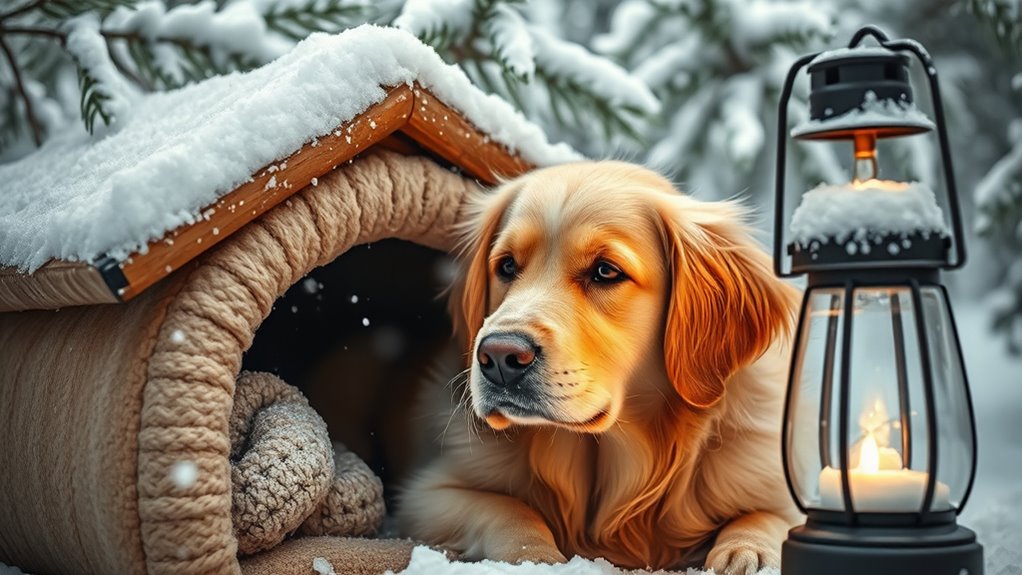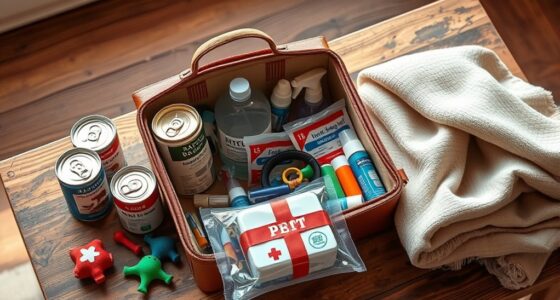To protect your pets during winter, keep them warm with well-fitting sweaters or jackets, especially if they have short fur or small breeds. Provide a dry, insulated shelter with thick bedding, and supervise outdoor time to avoid hypothermia or frostbite. Use protective boots to shield paws from salt and chemicals, checking regularly for irritation. Ensuring proper warmth, shelter, and paw care is vital—stay tuned to discover more winter safety tips to keep your pets safe.
Key Takeaways
- Dress pets in well-fitting sweaters or jackets that cover vital areas like the chest and belly to retain body heat.
- Provide insulated, elevated outdoor shelters with dry, thick bedding such as straw or thermal blankets.
- Use protective boots to shield paws from salt, chemicals, and de-icing agents, and regularly check for irritation or injury.
- Limit outdoor exposure and supervise pets to prevent hypothermia and frostbite, bringing them inside at signs of cold stress.
- Offer warm indoor retreats away from drafts and cold floors, ensuring a comfortable environment for indoor pets.

Winter weather can pose serious risks to your pets if you’re not prepared. Cold temperatures, snow, and ice can affect their health and safety in ways you might not immediately realize. As you gear up for the season, it’s important to think about keeping your furry friends warm and protected from the elements. One of the easiest ways to do this is by investing in cold weather clothing. A well-fitting sweater or jacket can help maintain your pet’s body heat, especially if they have short fur or are small breeds. Make sure any clothing you choose is comfortable, doesn’t restrict movement, and covers vital areas like the chest and belly. Remember, even with clothing, your pet’s exposure to cold should be limited. Prolonged outdoor time can lead to hypothermia or frostbite, so always supervise and bring them inside if they seem uncomfortable or cold. Additionally, monitoring their behavior and signs of cold stress can help prevent serious health issues.
Another aspect to think about is what your pet eats during the winter months. Holiday treats are common during this season, but not all are safe for animals. Keep chocolates, candies, and baked goods out of reach, as many holiday treats contain ingredients that are toxic to pets. Instead, offer them safe, vet-approved treats or small pieces of cooked meat or veggies. These can be a special way to celebrate without risking their health. Also, be cautious of salt, chemicals, and de-icing agents used on sidewalks and driveways. These substances can irritate your pet’s paws or even be ingested if they lick their paws after walking outside. Wearing protective boots can help shield their paws from these irritants and prevent them from slipping on icy surfaces.
Ensuring your pet has a warm, cozy shelter is just as essential as proper clothing and diet. If your pet spends time outdoors, make sure their shelter is insulated and elevated off the ground to prevent heat loss. Bedding should be thick, dry, and non-moisture-absorbing, like straw or thermal blankets, which retain warmth. Check regularly that their shelter remains dry and free from snow or ice buildup. For indoor pets, create a warm retreat away from drafts and cold floors, and keep blankets or pet beds accessible. Remember, pets are susceptible to cold just like humans, so adjusting their environment and routines accordingly helps prevent cold-related health issues. Incorporating proper shelter design can significantly improve outdoor pet safety during winter months.
Frequently Asked Questions
How Can I Prevent My Pet From Getting Frostbite?
To prevent your pet from getting frostbite, watch for signs like pale, cold, or hard skin, especially on paws, ears, and tail. Limit their outdoor time and provide warm, insulated shelter. Use protective gear such as doggy boots and sweaters for added warmth. Always check their paws for snow or ice buildup and bring them inside if they show any frostbite signs. Your vigilance keeps your pet safe and comfortable.
Are Certain Dog Breeds More Vulnerable to Winter Dangers?
Yes, certain dog breeds are more vulnerable to winter dangers due to breed susceptibility and winter susceptibility. Breeds with short coats, like Chihuahuas and Greyhounds, struggle to stay warm and are more prone to frostbite and hypothermia. Small or thin-coated dogs, as well as puppies and seniors, need extra protection. Keep these dogs indoors, provide cozy shelter, and limit outdoor exposure to guarantee their safety in cold weather.
What’s the Best Way to Keep My Cat Warm Indoors?
To keep your cat warm indoors, you should use indoor heating to maintain a comfortable temperature and provide cozy bedding in quiet, draft-free areas. Make sure to elevate their bed off cold floors, add soft blankets, and consider a heated pad if needed. Keep curtains closed at night to trap warmth, and guarantee your cat can access warm spots during colder days. These steps will help your feline stay cozy and safe.
How Do I Recognize Cold-Related Health Issues in Pets?
Like a vigilant guardian, you must recognize cold-related health issues in pets early. Watch for symptoms such as shivering, lethargy, and pale or cold extremities. If you notice these signs, act quickly—bring your pet indoors, warm them gently, and seek emergency response if symptoms worsen. Prompt symptom identification can prevent serious health problems, ensuring your furry friend’s safety and comfort during chilly days.
Can Winter Weather Affect My Pet’s Outdoor Exercise Routines?
Winter weather can definitely affect your pet’s outdoor exercise routines by introducing winter hazards like ice, snow, and cold temperatures. You should monitor their outdoor safety carefully, keeping walks shorter and avoiding icy patches. Be aware of signs of discomfort or cold-related health issues, and always provide warmth and shelter when they return indoors. Adjust routines as needed to keep your pet safe and comfortable during winter months.
Conclusion
Remember, keeping your pet warm, sheltered, and paws protected during winter is vital. For example, if you don’t provide a cozy shelter and paw protection, your dog could develop frostbite or chapped paws. Always check on them frequently and observe for signs of cold discomfort. By taking these simple steps, you guarantee your furry friend stays safe and happy all winter long, enjoying the season just as much as you do.










